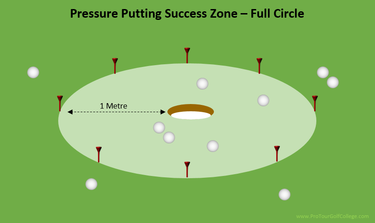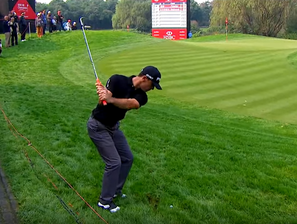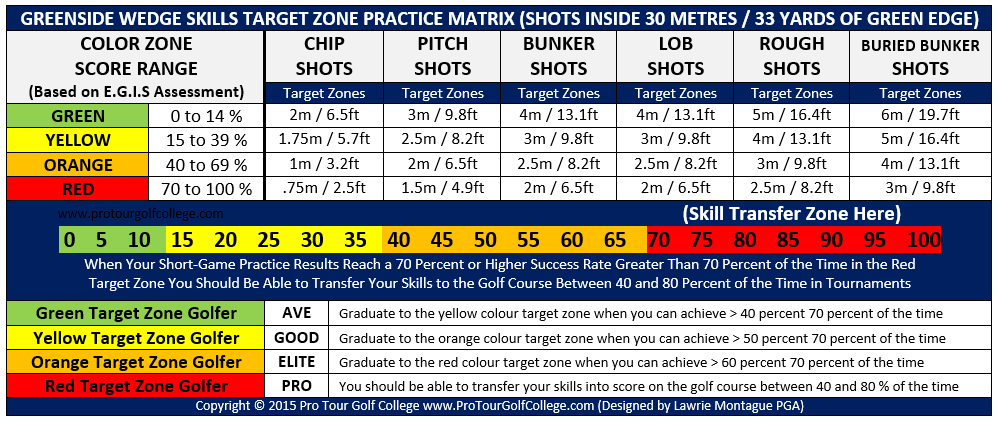|
A question we get asked frequently is "how can I improve my golf practice skills so I can improve my scoring on the golf course in tournaments?" It's a great question, and in this article we will share some of the many ways we help students in our programs in Perth and Jakarta to Practice On The Edge to play better on the golf course. At Pro Tour Golf College, we developed and use a unique golf training system with our students which comprehensively assesses a golfer’s skills in 6 major categories, and 18 sub categories, from short putting to driving from the tee through to golf course management. We do this to determine a golfer’s skill baseline in each category.  Golf Practice on the Edge Once we know what their baseline is for each skill category we design their training sessions with the explicit intention of helping them to practice right on the edge of their capability. Why is this important? Well, in our experience most golfers we observe on a daily basis really don’t know how to practice to improve the way they play on the golf course. You see, in order to improve your golf score, you need to be able to effectively transfer your golf practice skills onto the golf course, and to do this you need to put your skills under increasing amounts of pressure when you practice. The big idea here is to practice in such a way that your nervous system is continually having to adapt to increased practice pressure demands so that when you have to hit a shot that matters on the golf course, you have more chance of pulling it off. This is what Golf Practice On the Edge means. Golf Practice in the Comfort Zone Unfortunately, most golfers (even elite amateurs and pro’s) display a tendency for hitting golf shots on the range and practice green to easy targets with clubs they have more confidence using, whilst avoiding using clubs they have less confidence in. I’m sure you can see the problem in this approach? Have you developed the habit of going to your local practice range and when you arrive you expect to practice from the same mat or position on the driving range almost every time? We call this Golf Practice in the Comfort Zone. This approach to golf practice is not practicing right on the edge of your capability, it's practicing in the comfort zone, and it will not help you to play better on the golf course. Study the matrix below to understand the important relationship between Challenge Level and Skill Level. You should be designing your golf practice to a level of uncomfortable (Ideal Stress) by increasing the challenge level to put your skills under more pressure, without making it so difficult that you go into the frustration zone. We have seen lots of golfers do this, however with a slight adjustment of target size or shot type, this can easily move into the Ideal Stress Zone. The Greenside Wedge Skills Target Zone Matrix (Below) will be a helpful guide for designing your short-game practice sessions so you are practicing right on the edge of your capability. The following practice routines are some of the routines we use on a weekly basis to push our students into the Ideal Stress Zone where they can develop the skill and confidence to compete on the golf course more effectively.  Pressure Putting Gate Drill When you practice short putts of 3 feet to 10 feet (1 metre to 3 metres), you can make entry into the hole more challenging by placing 4 tee’s equal distance from one another around the edge of the hole just like the 4 points of a compass. The idea here is to build a gate that forces you to putt correct line and speed into the hole, and each time you hit a tee you must start again. Your goal is to successfully hit one set of 10 putts into the hole without hitting a tee.  Pressure Putting Success Zone – Half Circle On longer putts of 15 to 30 feet (5 to 10 metres) from the hole create a half circle success zone behind the front of the hole with a radius of 3 feet (1 metre) from the back edge of the hole to 5 tees set up in a half or semi-circle, and set your goal of getting at-least 70 percent of your putts into this defined success zone.  Pressure Putting Success Zone – Full Circle On extra-long putts of 50 to 100 feet (15 to 30 metres) from the hole create a full circle success zone surrounding the hole with a radius of 3 feet (1 metre) from the edge of the hole to 8 tees set up in a full circle surrounding the hole and set your goal of getting at-least 70 percent of your putts into this defined success zone. The objective with the long putting drills is to stroke a high percentage of your putts from various locations around the green into the success zone as consistently as you can. An Important Point to Remember When setting up and performing these practice routines is to practice from many locations to the target rather than from the same location. Variety is said to be the spice of life and it's also the ideal way to practice these routines. Change the location continually so you have to keep adapting.  Tee-Shot Pressure Practice As you know from personal experience most golfers want to hit their irons and woods further. However, the reality is that accuracy combined with distance off the tee with accurate shots into the green is the basic requirement if you want to lower your golf score. So for tee-shot practice pick targets on the practice range that are a similar width to the fairways at the golf course where you play. For example, the practice net support posts at the back of a lot of practice ranges make ideal target zones for hitting tee-shots. Look for target posts that are no wider than 50 to 65 feet (15 to 20 metres), and when you practice hitting your driver, see if you can hit 7 out of 10 tee-shots into your defined target zone. The higher the percentage of your tee shots that land within your defined target zone, the more likely you are to transfer this skill to the golf course.  Get to work on driving your game from the golf range to the golf course by designing practice sessions that move you from the Comfort Zone to the Ideal Stress Zone. Remember that most golfers are not doing this so you will develop a very real competitive advantage by adopting this approach to your golf practice. Continually change the practice conditions to adapt and grow your skills so you can perform under pressure on the golf course better than your competitors. We wish you the best of luck with your game and appreciate you taking the time to read our article. Lawrie Montague and David Milne - Pro Tour Golf College Perth Western Australia and Jakarta Indonesia |
Archives
June 2019
|
Proudly Supported By
Copyright © 2011 - 2018 Pro Tour Golf College
Website Managed By Golf Performance Media
All Rights Reserved
Website Managed By Golf Performance Media
All Rights Reserved







 RSS Feed
RSS Feed



